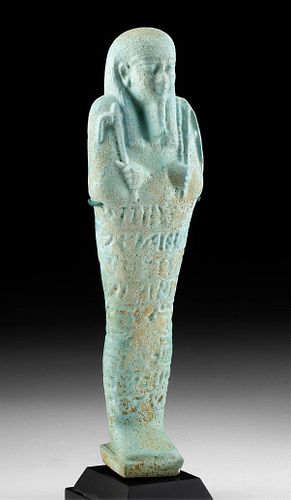Tall / Translated Egyptian 30th Dynasty Faience Ushabti
Lot 1
About Seller
Artemis Fine Arts
686 S Taylor Ave, Ste 106
Louisville, CO 80027
United States
Selling antiquities, ancient and ethnographic art online since 1993, Artemis Gallery specializes in Classical Antiquities (Egyptian, Greek, Roman, Near Eastern), Asian, Pre-Columbian, African / Tribal / Oceanographic art. Our extensive inventory includes pottery, stone, metal, wood, glass and textil...Read more
Estimate:
$9,000 - $14,000
Absentee vs Live bid
Two ways to bid:
- Leave a max absentee bid and the platform will bid on your behalf up to your maximum bid during the live auction.
- Bid live during the auction and your bids will be submitted real-time to the auctioneer.
Bid Increments
| Price | Bid Increment |
|---|---|
| $0 | $25 |
| $300 | $50 |
| $1,000 | $100 |
| $2,000 | $250 |
| $5,000 | $500 |
| $10,000 | $1,000 |
| $20,000 | $2,500 |
| $50,000 | $5,000 |
| $100,000 | $10,000 |
| $200,000 | $20,000 |
About Auction
By Artemis Fine Arts
Dec 2, 2021
Set Reminder
2021-12-02 10:00:00
2021-12-02 10:00:00
America/New_York
Bidsquare
Bidsquare : Fine Antiquities | Asian | Ethnographic Art
https://www.bidsquare.com/auctions/artemis-gallery/fine-antiquities-asian-ethnographic-art-7918
Features classical antiquities, ancient and ethnographic art from cultures encompassing the globe. Egyptian, Greek, Roman, Etruscan, Near Eastern, Asian, Pre-Columbian, Native American, African / Tribal, Oceanic, Spanish Colonial, Russian, Fine / Visual Arts, so much more! Artemis Fine Arts info@artemisfinearts.com
Features classical antiquities, ancient and ethnographic art from cultures encompassing the globe. Egyptian, Greek, Roman, Etruscan, Near Eastern, Asian, Pre-Columbian, Native American, African / Tribal, Oceanic, Spanish Colonial, Russian, Fine / Visual Arts, so much more! Artemis Fine Arts info@artemisfinearts.com
- Lot Description
Egypt, Late Dynastic Period, 30th Dynasty, ca. 380 to 343 BCE. A fantastic mold-formed faience ushabti covered in soft turquoise-hued glaze. The figure stands in mummiform with fused legs and a dorsal pillar atop an integral rectangular plinth, holds a raised pick and hoe in hands crossed on the chest, and has a textured strap supporting a seed bag behind the left shoulder. The serene visage bears almond-shaped eyes with elongated canthi beneath thin brows, a slender nose, cupped ears, and a plaited false beard, all beneath an elegantly pleated tripartite wig. Nine lines of inscribed hieroglyphic text identify this individual as Semataui (also Sema-Taui, Semitaui) - a Sameref priest and commander of Egyptian military troops - that provide him with blessings for his journey through the afterlife. Size: 2.4" W x 8.625" H (6.1 cm x 21.9 cm); 9.25" H (23.5 cm) on included custom stand.
This ushabti and many others like it were meant to be placed inside a tomb for the inscribed individual to aid them both in their journey to the afterlife as well as the duties prescribed to them. When translated, this ushabti reads, "The Illuminated, the Osiris, the Sameref priest, commander of the troop, Semataui, son of Sheri, born of Tashepset, justified, he says: O these ushabtis, if counted upon, the Osiris, the Sameref priest, commander of the troop, Semataui, son of Sheri, born of Tashepset, justified, to do all the works that are to be done there in the realm of the dead - now indeed obstacles are implanted there - as a man at his duties, 'here I am!' you shall say when you are counted upon at any time to serve there, to cultivate the fields, to irrigate the river banks, to ferry the sand of the west to the east and vice-versa, 'here I am' you shall say."
This is an interesting ushabti, because the names of the inscribed individuals tell us where Semataui lived. The inscribed names indicate that this individual was from Heracleopolis because his name "Semataui" (Greek Somtous, translated as "he who unifies the two lands") represents a provincial falcon-headed deity who was worshipped in this part of Egypt. The title bestowed to Semataui of "Sameref" (meaning "the son whom he loves") is a priestly title associated with Heracleopolis Magna (Middle Egypt). The name of his father, "Sheri" (meaning "the child"), as well as the name of his mother, "Tasepsetherti" (meaning "the noble one is content"), are also indicative of Middle Egyptian origin.
Provenance: East Coast collection, New York Gallery, New York City, New York, USA, acquired before 2010
All items legal to buy/sell under U.S. Statute covering cultural patrimony Code 2600, CHAPTER 14, and are guaranteed to be as described or your money back.
A Certificate of Authenticity will accompany all winning bids.
PLEASE NOTE: Due to recent increases of shipments being seized by Australian & German customs (even for items with pre-UNESCO provenance), we will no longer ship most antiquities and ancient Chinese art to Australia & Germany. For categories of items that are acceptable to ship to Australia or Germany, please contact us directly or work with your local customs brokerage firm.
Display stands not described as included/custom in the item description are for photography purposes only and will not be included with the item upon shipping.
#149849Minor chips to base, legs, body, and head, with softening to some finer details and inscribed hieroglyphic characters, light fading to original glaze pigmentation, and some pitting, otherwise intact and excellent. Great traces of original glaze pigment throughout, and most hieroglyphic characters are still legible.Condition
- Shipping Info
-
All shipping is handled in-house for your convenience. Your invoice from Artemis Gallery will include shipping calculation instructions. If in doubt, please inquire BEFORE bidding for estimated shipping costs for individual items.
-
- Buyer's Premium



 EUR
EUR CAD
CAD AUD
AUD GBP
GBP MXN
MXN HKD
HKD CNY
CNY MYR
MYR SEK
SEK SGD
SGD CHF
CHF THB
THB














